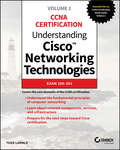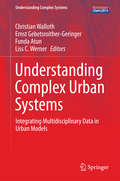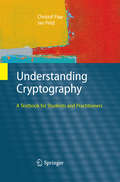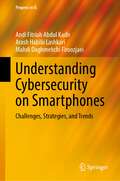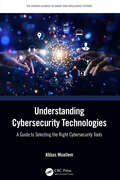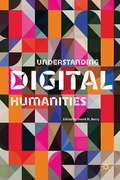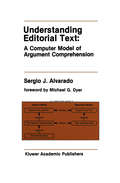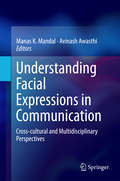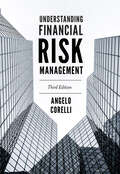- Table View
- List View
Understanding Cisco Networking Technologies, Volume 1: Exam 200-301
by Todd LammleLeading Cisco authority Todd Lammle helps you gain insights into the new core Cisco network technologies Understanding Cisco Networking Technologies is an important resource for those preparing for the new Cisco Certified Network Associate (CCNA) certification exam as well as IT professionals looking to understand Cisco’s latest networking products, services, and technologies. Written by bestselling author and internationally recognized Cisco expert Todd Lammle, this in-depth guide provides the fundamental knowledge required to implement and administer a broad range of modern networking and IT infrastructure. Cisco is the worldwide leader in network technologies—80% of the routers on the Internet are Cisco. This authoritative book provides you with a solid foundation in Cisco networking, enabling you to apply your technical knowledge to real-world tasks. Clear and accurate chapters cover topics including routers, switches, controllers and other network components, physical interface and cabling, IPv6 addressing, discovery protocols, wireless infrastructure, security features and encryption protocols, controller-based and software-defined architectures, and more. After reading this essential guide, you will understand: Network fundamentals Network access IP connectivity and IP services Security fundamentals Automation and programmability Understanding Cisco Networking Technologies is a must-read for anyone preparing for the new CCNA certification or looking to gain a primary understanding of key Cisco networking technologies.
Understanding Complex Datasets: Data Mining with Matrix Decompositions
by David SkillicornMaking obscure knowledge about matrix decompositions widely available, Understanding Complex Datasets: Data Mining with Matrix Decompositions discusses the most common matrix decompositions and shows how they can be used to analyze large datasets in a broad range of application areas. Without having to understand every mathematical detail, the book
Understanding Complex Urban Systems: Integrating Multidisciplinary Data in Urban Models (Understanding Complex Systems)
by Christian Walloth Ernst Gebetsroither-Geringer Funda Atun Liss C. WernerThis book is devoted to the modeling and understanding of complex urban systems. This second volume of Understanding Complex Urban Systems focuses on the challenges of the modeling tools, concerning, e.g., the quality and quantity of data and the selection of an appropriate modeling approach. It is meant to support urban decision-makers—including municipal politicians, spatial planners, and citizen groups—in choosing an appropriate modeling approach for their particular modeling requirements. The contributors to this volume are from different disciplines, but all share the same goal: optimizing the representation of complex urban systems. They present and discuss a variety of approaches for dealing with data-availability problems and finding appropriate modeling approaches—and not only in terms of computer modeling. The selection of articles featured in this volume reflect a broad variety of new and established modeling approaches such as: - An argument for using Big Data methods in conjunction with Agent-based Modeling; - The introduction of a participatory approach involving citizens, in order to utilize an Agent-based Modeling approach to simulate urban-growth scenarios; - A presentation of semantic modeling to enable a flexible application of modeling methods and a flexible exchange of data; - An article about a nested-systems approach to analyzing a city’s interdependent subsystems (according to these subsystems’ different velocities of change); - An article about methods that use Luhmann’s system theory to characterize cities as systems that are composed of flows; - An article that demonstrates how the Sen-Nussbaum Capabilities Approach can be used in urban systems to measure household well-being shifts that occur in response to the resettlement of urban households; - A final article that illustrates how Adaptive Cycles of Complex Adaptive Systems, as well as innovation, can be applied to gain a better understanding of cities and to promote more resilient and more sustainable urban futures.
Understanding Complexity
by Gillian Ragsdell Jennifer WilbyPeter A. Coming Palo Alto, CA November, 2000 This volwne represents a distillation of the plenary sessions at a unique millenniwn year event -a World Congress of the Systems Sciences in conjunction with the 44th annual meeting of the International Society for the Systems Sciences (ISSS). The overall theme of the conference was "Understanding Complexity in the New Millenniwn. " Held at Ryerson Polytechnic University in Toronto, Canada, from July 16-22,2000, the conference included some 350 participants from over 30 countries, many of whom were representatives of the 21 organizations and groups that co-hosted this landmark event. Each of these co-host organizations/groups also presented a segment of the program, including a plenary speech. In addition, the conference featured a nwnber of distinguished "keynote" speeches related to the three daily World Congress themes: (1) The Evolution of Complex Systems, (2) The Dynamics of Complex Systems, and (3) Human Systems in the 21st Century. There were also seven special plenary-level symposia on a range of timely topics, including: "The Art and Science of Forecasting in the Age of Global Wanning"; "Capitalism in the New Millenniwn: The Challenge of Sustainability"; "The Future of the Systems Sciences"; "Global Issues in the New Millenniwn"; "Resources and the Environment in the New Millenniwn"; "The Lessons of Y2K"; and "Can There be a Reconciliation Between Science and Religion?" Included in this special commemorative volume is a cross-section of these presentations.
Understanding Computation: Pillars, Paradigms, Principles (Texts in Computer Science)
by Arnold L. Rosenberg Lenwood S. HeathComputation theory is a discipline that uses mathematical concepts and tools to expose the nature of "computation" and to explain a broad range of computational phenomena: Why is it harder to perform some computations than others? Are the differences in difficulty that we observe inherent, or are they artifacts of the way we try to perform the computations? How does one reason about such questions? This unique textbook strives to endow students with conceptual and manipulative tools necessary to make computation theory part of their professional lives. The work achieves this goal by means of three stratagems that set its approach apart from most other texts on the subject. For starters, it develops the necessary mathematical concepts and tools from the concepts' simplest instances, thereby helping students gain operational control over the required mathematics. Secondly, it organizes development of theory around four "pillars," enabling students to see computational topics that have the same intellectual origins in physical proximity to one another. Finally, the text illustrates the "big ideas" that computation theory is built upon with applications of these ideas within "practical" domains in mathematics, computer science, computer engineering, and even further afield. Suitable for advanced undergraduate students and beginning graduates, this textbook augments the "classical" models that traditionally support courses on computation theory with novel models inspired by "real, modern" computational topics,such as crowd-sourced computing, mobile computing, robotic path planning, and volunteer computing. Arnold L. Rosenberg is Distinguished Univ. Professor Emeritus at University of Massachusetts, Amherst, USA. Lenwood S. Heath is Professor at Virgina Tech, Blacksburg, USA.
Understanding Computer Organization: A Guide to Principles Across RISC-V, ARM Cortex, and Intel Architectures (Undergraduate Topics in Computer Science)
by Patricio BulićThis textbook unlocks modern computer organizations' secrets, with real-world examples from RISC-V, ARM, and Intel-based computer systems. The guide provides a comprehensive yet accessible explanation of fundamental principles and components and serves as a gateway to mastering the interplay between hardware and software. It demystifies complex concepts and provides clear explanations and practical insights into their roles in computing systems. Topics and features: Provides comprehensive coverage of computer organization principles across three major architectures (RISC-V, ARM Cortex, and Intel), ensuring a broad understanding of modern computing Includes numerous practical explanations using real-world examples from each architecture, offering hands-on insights into memory-mapped I/O, interrupts, DMA, and various memory technologies Presents detailed exploration of diverse components such as interrupts and their usage, interrupt controllers, DMA transfers, and DMA controllers Offers exploration of DDRx SDRAM memory, SDRAM controllers, DIMM modules, caches, and virtual memory Concise and yet thorough, this useful textbook/guide equips readers with the knowledge and skills needed to navigate the complexities of computer organization, making it essential reading for students and professionals.
Understanding Concurrent Systems (Texts in Computer Science)
by A.W. RoscoeCSP notation has been used extensively for teaching and applying concurrency theory, ever since the publication of the text Communicating Sequential Processes by C.A.R. Hoare in 1985. Both a programming language and a specification language, the theory of CSP helps users to understand concurrent systems, and to decide whether a program meets its specification. As a member of the family of process algebras, the concepts of communication and interaction are presented in an algebraic style. An invaluable reference on the state of the art in CSP, Understanding Concurrent Systems also serves as a comprehensive introduction to the field, in addition to providing material for a number of more advanced courses. A first point of reference for anyone wanting to use CSP or learn about its theory, the book also introduces other views of concurrency, using CSP to model and explain these. The text is fully integrated with CSP-based tools such as FDR, and describes how to create new tools based on FDR. Most of the book relies on no theoretical background other than a basic knowledge of sets and sequences. Sophisticated mathematical arguments are avoided whenever possible. Topics and features: presents a comprehensive introduction to CSP; discusses the latest advances in CSP, covering topics of operational semantics, denotational models, finite observation models and infinite-behaviour models, and algebraic semantics; explores the practical application of CSP, including timed modelling, discrete modelling, parameterised verifications and the state explosion problem, and advanced topics in the use of FDR; examines the ability of CSP to describe and enable reasoning about parallel systems modelled in other paradigms; covers a broad variety of concurrent systems, including combinatorial, timed, priority-based, mobile, shared variable, statecharts, buffered and asynchronous systems; contains exercises and case studies to support the text; supplies further tools and information at the associated website: http://www.comlab.ox.ac.uk/ucs/. From undergraduate students of computer science in need of an introduction to the area, to researchers and practitioners desiring a more in-depth understanding of theory and practice of concurrent systems, this broad-ranging text/reference is essential reading for anyone interested in Hoare’s CSP.
Understanding Control Flow: Concurrent Programming Using μC++
by Peter A. BuhrThe control-flow issues presented in this textbook are extremely relevant in modern computer languages and programming styles. In addition to the basic control-flow mechanisms, virtually all new computer languages provide some form of exceptional control flow to support robust programming introduced in this textbook. Also, concurrency capabilities are appearing with increasing frequency in both new and old programming languages, and are covered in this book. Understanding Control Flow: With Concurrent Programming Using μC++ starts with looping, and works through each of the basic control-flow concepts, examining why each is fundamental and where it is useful. Time is spent on each concept according to its level of difficulty. Examples and exercises are also provided in this textbook. New programming methodologies are requiring new forms of control flow, and new programming languages are supporting these methodologies with new control structures, such as the concurrency constructs discussed in this textbook. Most computers now contain multi-threading and multi-cores, while multiple processors and distributed systems are ubiquitous — all of which require advanced programming methodologies to take full advantage of the available parallelism summarized in this textbook. Advance forms of control flow are becoming basic programming skills needed by all programmers, not just graduate students working in the operating systems or database disciplines. This textbook is designed for advanced-level students studying computer science and engineering. Professionals and researchers working in this field, specifically programming and software engineering, will find this book useful as a reference.
Understanding Counterplay in Video Games (Routledge Advances in Game Studies)
by Alan F. MeadesThis book offers insight into one of the most problematic and universal issues within multiplayer videogames: antisocial and oppositional play forms such as cheating, player harassment, the use of exploits, illicit game modifications, and system hacking, known collectively as counterplay. Using ethnographic research, Alan Meades not only to gives voice to counterplayers, but reframes counterplay as a complex practice with contradictory motivations that is anything but reducible to simply being hostile to play, players, or commercial videogames. The book offers a grounded and pragmatic exploration of counterplay, framing it as an unavoidable by-product of interaction of mass audiences with compelling and culturally important texts.
Understanding Counterplay in Video Games (Routledge Advances in Game Studies)
by Alan F. MeadesThis book offers insight into one of the most problematic and universal issues within multiplayer videogames: antisocial and oppositional play forms such as cheating, player harassment, the use of exploits, illicit game modifications, and system hacking, known collectively as counterplay. Using ethnographic research, Alan Meades not only to gives voice to counterplayers, but reframes counterplay as a complex practice with contradictory motivations that is anything but reducible to simply being hostile to play, players, or commercial videogames. The book offers a grounded and pragmatic exploration of counterplay, framing it as an unavoidable by-product of interaction of mass audiences with compelling and culturally important texts.
Understanding COVID-19: The Role of Computational Intelligence (Studies in Computational Intelligence #963)
by Janmenjoy Nayak Bighnaraj Naik Ajith AbrahamThis book provides a comprehensive description of the novel coronavirus infection, spread analysis, and related challenges for the effective combat and treatment. With a detailed discussion on the nature of transmission of COVID-19, few other important aspects such as disease symptoms, clinical application of radiomics, image analysis, antibody treatments, risk analysis, drug discovery, emotion and sentiment analysis, virus infection, and fatality prediction are highlighted. The main focus is laid on different issues and futuristic challenges of computational intelligence techniques in solving and identifying the solutions for COVID-19. The book drops radiance on the reasons for the growing profusion and complexity of data in this sector. Further, the book helps to focus on further research challenges and directions of COVID-19 for the practitioners as well as researchers.
Understanding Crypto Fundamentals: Value Investing in Cryptoassets and Management of Underlying Risks
by Thomas JeegersSaying that many investors were not convinced by cryptocurrencies in their first decade of existence would be an understatement. Originally, author Thomas Jeegers was one of them. He looked into this new virtual money more than once and, each time, decided not to invest. Like many long-term investors, he was looking for fundamentals. Crypto had none — or so he thought. This book details why his perspective on cryptoassets has shifted – and why yours should, too. Recent developments in this field have turned crypto from a speculative financial innovation to a new asset class, one with a new kind of fundamentals that offer real economic value. One that will change finance and investments. One that may be a trigger defining the fourth industrial revolution, the same way steam, electricity, and the Internet were triggers for the first, second, and third industrial revolutions, respectively. Despite what advocates of the traditional financial establishment like to claim, cryptoassets were by far the best financial investment of the last decade, even risk-adjusted, and could still be so for the coming one. They should not be overlooked, regardless of one’s opinion of them. This book answers the main questions any potential long-term investor in cryptoassets should ask: What are cryptoassets and blockchain technology?Why consider cryptoasset investments?When is a good time to invest?Where should one invest? How should one invest? Which valuation methods are appropriate? Understanding Crypto Fundamentals includes a deep dive into the management of risks specific to cryptoassets, both financial and non-financial, and provides the tools needed for investment success in this new asset class. Upon completing the book, you will have a new perspective on cryptoassets and how you can benefit from them as an investor.Thomas Jeegers is a CFA Charterholder and Financial Risk Manager (FRM), and has earned an MBA from INSEAD as well as multiple blockchain certifications from institutions including INSEAD and Oxford University. He has worked in finance for 10 years and is a frequent speaker at events on blockchain and cryptoassets.
Understanding Cryptography: From Established Symmetric and Asymmetric Ciphers to Post-Quantum Algorithms
by Tim Güneysu Christof Paar Jan PelzlUnderstanding and employing cryptography has become central for securing virtually any digital application, whether user app, cloud service, or even medical implant.Heavily revised and updated, the long-awaited second edition of Understanding Cryptography follows the unique approach of making modern cryptography accessible to a broad audience, requiring only a minimum of prior knowledge. After introducing basic cryptography concepts, this seminal textbook covers nearly all symmetric, asymmetric, and post-quantum cryptographic algorithms currently in use in applications—ranging from cloud computing and smart phones all the way to industrial systems, block chains, and cryptocurrencies.Topics and features:Opens with a foreword by cryptography pioneer and Turing Award winner, Ron RivestHelps develop a comprehensive understanding of modern applied cryptographyProvides a thorough introduction to post-quantum cryptography consisting of the three standardized cipher familiesIncludes for every chapter a comprehensive problem set, extensive examples, and a further-reading discussionCommunicates, using a unique pedagogical approach, the essentials about foundations and use in practice, while keeping mathematics to a minimumSupplies up-to-date security parameters for all cryptographic algorithmsIncorporates chapter reviews and discussion on such topics as historical and societal contextThis must-have book is indispensable as a textbook for graduate and advanced undergraduate courses, as well as for self-study by designers and engineers.The authors have more than 20 years’ experience teaching cryptography at various universities in the US and Europe. In addition to being renowned scientists, they have extensive experience with applying cryptography in industry, fromwhich they have drawn important lessons for their teaching.
Understanding Cryptography: A Textbook for Students and Practitioners
by Christof Paar Jan PelzlCryptography is now ubiquitous – moving beyond the traditional environments, such as government communications and banking systems, we see cryptographic techniques realized in Web browsers, e-mail programs, cell phones, manufacturing systems, embedded software, smart buildings, cars, and even medical implants. Today's designers need a comprehensive understanding of applied cryptography. After an introduction to cryptography and data security, the authors explain the main techniques in modern cryptography, with chapters addressing stream ciphers, the Data Encryption Standard (DES) and 3DES, the Advanced Encryption Standard (AES), block ciphers, the RSA cryptosystem, public-key cryptosystems based on the discrete logarithm problem, elliptic-curve cryptography (ECC), digital signatures, hash functions, Message Authentication Codes (MACs), and methods for key establishment, including certificates and public-key infrastructure (PKI). Throughout the book, the authors focus on communicating the essentials and keeping the mathematics to a minimum, and they move quickly from explaining the foundations to describing practical implementations, including recent topics such as lightweight ciphers for RFIDs and mobile devices, and current key-length recommendations. The authors have considerable experience teaching applied cryptography to engineering and computer science students and to professionals, and they make extensive use of examples, problems, and chapter reviews, while the book’s website offers slides, projects and links to further resources. This is a suitable textbook for graduate and advanced undergraduate courses and also for self-study by engineers.
Understanding Cybersecurity Law in Data Sovereignty and Digital Governance: An Overview from a Legal Perspective (Progress in IS)
by Melissa Lukings Arash Habibi LashkariThis book provides an overview of the topics of data, sovereignty, and governance with respect to data and online activities through a legal lens and from a cybersecurity perspective. This first chapter explores the concepts of data, ownerships, and privacy with respect to digital media and content, before defining the intersection of sovereignty in law with application to data and digital media content. The authors delve into the issue of digital governance, as well as theories and systems of governance on a state level, national level, and corporate/organizational level. Chapter three jumps into the complex area of jurisdictional conflict of laws and the related issues regarding digital activities in international law, both public and private. Additionally, the book discusses the many technical complexities which underlay the evolution and creation of new law and governance strategies and structures. This includes socio-political, legal, and industrial technical complexities which can apply in these areas. The fifth chapter is a comparative examination of the legal strategies currently being explored by a variety of nations. The book concludes with a discussion about emerging topics which either influence, or are influenced by, data sovereignty and digital governance, such as indigenous data sovereignty, digital human rights and self-determination, artificial intelligence, and global digital social responsibility. Cumulatively, this book provides the full spectrum of information, from foundational principles underlining the described topics, through to the larger, more complex, evolving issues which we can foresee ahead of us.
Understanding Cybersecurity Management in Decentralized Finance: Challenges, Strategies, and Trends (Financial Innovation and Technology)
by Gurdip Kaur Arash Habibi Lashkari Iman Sharafaldin Ziba Habibi LashkariThis book discusses understand cybersecurity management in decentralized finance (DeFi). It commences with introducing fundamentals of DeFi and cybersecurity to readers. It emphasizes on the importance of cybersecurity for decentralized finance by illustrating recent cyber breaches, attacks, and financial losses. The book delves into understanding cyber threats and adversaries who can exploit those threats. It advances with cybersecurity threat, vulnerability, and risk management in DeFi. The book helps readers understand cyber threat landscape comprising different threat categories for that can exploit different types of vulnerabilities identified in DeFi. It puts forward prominent threat modelling strategies by focusing on attackers, assets, and software. The book includes the popular blockchains that support DeFi include Ethereum, Binance Smart Chain, Solana, Cardano, Avalanche, Polygon, among others. With so much monetary value associated with all these technologies, the perpetrators are always lured to breach security by exploiting the vulnerabilities that exist in these technologies. For simplicity and clarity, all vulnerabilities are classified into different categories: arithmetic bugs, re-Entrancy attack, race conditions, exception handling, using a weak random generator, timestamp dependency, transaction-ordering dependence and front running, vulnerable libraries, wrong initial assumptions, denial of service, flash loan attacks, and vampire Since decentralized finance infrastructures are the worst affected by cyber-attacks, it is imperative to understand various security issues in different components of DeFi infrastructures and proposes measures to secure all components of DeFi infrastructures. It brings the detailed cybersecurity policies and strategies that can be used to secure financial institutions. Finally, the book provides recommendations to secure DeFi infrastructures from cyber-attacks.
Understanding Cybersecurity Management in FinTech: Challenges, Strategies, and Trends (Future of Business and Finance)
by Gurdip Kaur Ziba Habibi Lashkari Arash Habibi LashkariThis book uncovers the idea of understanding cybersecurity management in FinTech. It commences with introducing fundamentals of FinTech and cybersecurity to readers. It emphasizes on the importance of cybersecurity for financial institutions by illustrating recent cyber breaches, attacks, and financial losses. The book delves into understanding cyber threats and adversaries who can exploit those threats. It advances with cybersecurity threat, vulnerability, and risk management in FinTech. The book helps readers understand cyber threat landscape comprising different threat categories that can exploit different types of vulnerabilties identified in FinTech. It puts forward prominent threat modelling strategies by focusing on attackers, assets, and software and addresses the challenges in managing cyber risks in FinTech. The authors discuss detailed cybersecurity policies and strategies that can be used to secure financial institutions and provide recommendations to secure financial institutions from cyber-attacks.
Understanding Cybersecurity Management in Healthcare: Challenges, Strategies and Trends (Progress in IS)
by Arash Habibi Lashkari Dilli Prasad Sharma Mona ParizadehDigital technology is increasingly used in the healthcare sector, and healthcare organizations handle sensitive and confidential information that needs to be kept secure and protected. Therefore, the importance of cybersecurity in healthcare cannot be overstated. Cyber threats can compromise patient data, disrupt healthcare services, and put personal safety at risk. This book provides an understanding of cybersecurity in healthcare, which is crucial for protecting personal information, ensuring compliance with regulations, maintaining patient trust, and preventing cyber-attacks. Before defining cybersecurity in healthcare, the authors introduce the healthcare environment and cybersecurity basics to readers. They then emphasize the importance of data protection and privacy, software, and personal cybersecurity. Also, they highlight the importance of educating staff about cybersecurity. The discussion continues with data and information security in healthcare, including data threats and vulnerabilities, the difference between data protection and privacy, and how to protect data. Afterward, they focus on the software system frameworks and types of infra-security and app security in healthcare. A key goal of this book is to provide readers with an understanding of how to detect and prevent cyber-attacks in the healthcare sector and how to respond to and recover from them. Moreover, it gives them an insight into cybersecurity vulnerabilities in healthcare and how they are mitigated. A chapter on cybersecurity ethics and healthcare data governance frameworks is also included in the book. The last chapter explores the challenges healthcare organizations face in maintaining security compliance and security practice guidelines that exist. By understanding the risks and challenges of cybersecurity in healthcare, healthcare providers and organizations can better protect sensitive and confidential data and ensure the safety and privacy of those they serve.
Understanding Cybersecurity on Smartphones: Challenges, Strategies, and Trends (Progress in IS)
by Andi Fitriah Abdul Kadir Arash Habibi Lashkari Mahdi Daghmehchi FiroozjaeiThis book offers a comprehensive overview of smartphone security, focusing on various operating systems and their associated challenges. It covers the smartphone industry's evolution, emphasizing security and privacy concerns. It explores Android, iOS, and Windows OS security vulnerabilities and mitigation measures. Additionally, it discusses alternative OSs like Symbian, Tizen, Sailfish, Ubuntu Touch, KaiOS, Sirin, and HarmonyOS.The book also addresses mobile application security, best practices for users and developers, Mobile Device Management (MDM) in enterprise settings, mobile network security, and the significance of mobile cloud security and emerging technologies such as IoT, AI, ML, and blockchain. It discusses the importance of balancing innovation with solid security practices in the ever-evolving mobile technology landscape.
Understanding Cybersecurity Technologies: A Guide to Selecting the Right Cybersecurity Tools (The Human Element in Smart and Intelligent Systems)
by Abbas MoallemCyberattacks on enterprises, government institutions, and individuals are exponentially growing. At the same time, the number of companies, both small and large, offering all types of solutions has been increasing too. Since companies rely on technological solutions to protect themselves against cyberattacks, understanding and selecting the right solutions among those offered presents a significant challenge for professionals, company executives, and newcomers to the cybersecurity field.FEATURES Presents descriptions for each type of cybersecurity technology and their specifications Explains applications, usages, and offers case studies to enhance comprehension Offers an easy-to-understand classification of existing cybersecurity technologies Provides an understanding of the technologies without getting lost in technical details Focuses on existing technologies used in different solutions, without focusing on the companies that offer these technologies This book is intended to help all professionals new to cybersecurity, students, and experts to learn or educate their audiences on the foundations of the available solutions.
Understanding Cybersecurity Technologies: A Guide to Selecting the Right Cybersecurity Tools (The Human Element in Smart and Intelligent Systems)
by Abbas MoallemCyberattacks on enterprises, government institutions, and individuals are exponentially growing. At the same time, the number of companies, both small and large, offering all types of solutions has been increasing too. Since companies rely on technological solutions to protect themselves against cyberattacks, understanding and selecting the right solutions among those offered presents a significant challenge for professionals, company executives, and newcomers to the cybersecurity field.FEATURES Presents descriptions for each type of cybersecurity technology and their specifications Explains applications, usages, and offers case studies to enhance comprehension Offers an easy-to-understand classification of existing cybersecurity technologies Provides an understanding of the technologies without getting lost in technical details Focuses on existing technologies used in different solutions, without focusing on the companies that offer these technologies This book is intended to help all professionals new to cybersecurity, students, and experts to learn or educate their audiences on the foundations of the available solutions.
Understanding Digital Humanities
by David M. BerryConfronting the digital revolution in academia, this book examines the application of new computational techniques and visualisation technologies in the Arts & Humanities. Uniting differing perspectives, leading and emerging scholars discuss the theoretical and practical challenges that computation raises for these disciplines.
Understanding Editorial Text: A Computer Model of Argument Comprehension (The Springer International Series in Engineering and Computer Science #107)
by Sergio J. Alvaradoby Michael G. Dyer Natural language processing (NLP) is an area of research within Artificial Intelligence (AI) concerned with the comprehension and generation of natural language text. Comprehension involves the dynamic construction of conceptual representations, linked by causal relationships and organized/indexed for subsequent retrieval. Once these conceptual representations have been created, comprehension can be tested by means of such tasks as paraphrasing, question answering, and summarization. Higher-level cognitive tasks are also modeled within the NLP paradigm and include: translation, acquisition of word meanings and concepts through reading, analysis of goals and plans in multi-agent environments (e. g. , coalition and counterplanning behavior by narrative characters), invention of novel stories, recognition of abstract themes (such as irony and hypocrisy), extraction of the moral or point of a story, and justification/refutation of beliefs through argumentation. The robustness of conceptually-based text comprehension systems is directly related to the nature and scope of the knowledge constructs applied during conceptual analysis of the text. Until recently, conceptually-based natural language systems were developed for, and applied to, the task of narrative comprehension (Dyer, 1983a; Schank and Abelson, 1977; Wilensky, 1983). These systems worked by recognizing the goals and plans of narrative characters, and. using this knowledge to build a conceptual representation of the narrative, xx UNDERSTANDING EDITORIAL TEXT including actions and intentions which must be inferred to complete the representation. A large portion of text appearing in newspapers and magazines, however, is editorial in nature.
Understanding Facial Expressions in Communication: Cross-cultural and Multidisciplinary Perspectives
by Manas K. Mandal Avinash AwasthiThis important volume provides a holistic understanding of the cultural, psychological, neurological and biological elements involved in human facial expressions and of computational models in the analyses of expressions. It includes methodological and technical discussions by leading scholars across the world on the subject. Automated and manual analysis of facial expressions, involving cultural, gender, age and other variables, is a growing and important area of research with important implications for cross-cultural interaction and communication of emotion, including security and clinical studies. This volume also provides a broad framework for the understanding of facial expressions of emotion with inputs drawn from the behavioural sciences, computational sciences and neurosciences.
Understanding Financial Risk Management
by Angelo CorelliFinancial risk management is a topic of primary importance in financial markets. It is important to learn how to measure and control risk, how to be primed for the opportunity of compensative return, and how to avoid useless exposure. This third edition of Understanding Financial Risk Management offers an updated version of its innovative approach to such issues. Angelo Corelli analyses the various types of financial risk that a financial institution now face in everyday operations—including market, interest rate, credit, liquidity, operational, currency, volatility, and enterprise risk. He deals with each type of risk using a rigorous mix of analytical and theoretical approaches; he gives introductory overviews to the most relevant statistical and mathematical tools; and he provides innovative analyses of all the major models available in the literature. This broad view of theory and the current state of the industry provides a friendly but serious starting point for those who encounter risk management for the first time, and it offers plenty of food for thought to more advanced readers. For its unique mix of rigour and accessibility, this book is a must-read for finance professionals, and it is of keen interest to finance students and researchers.
